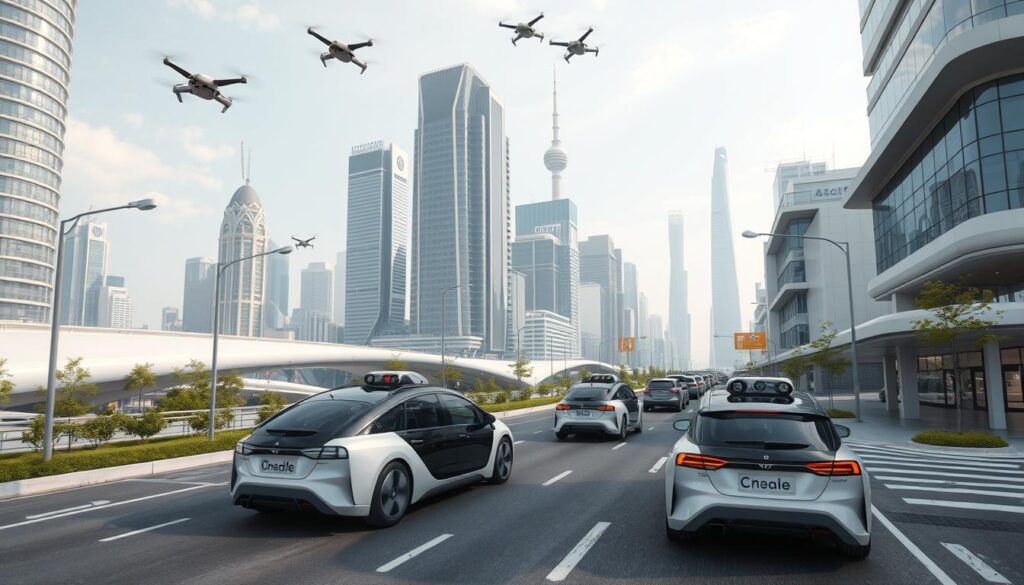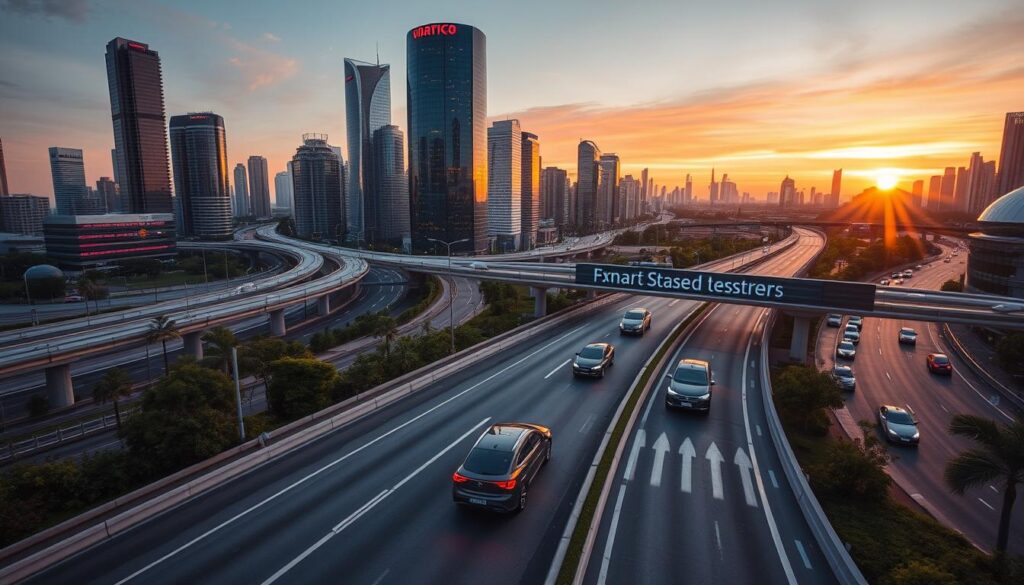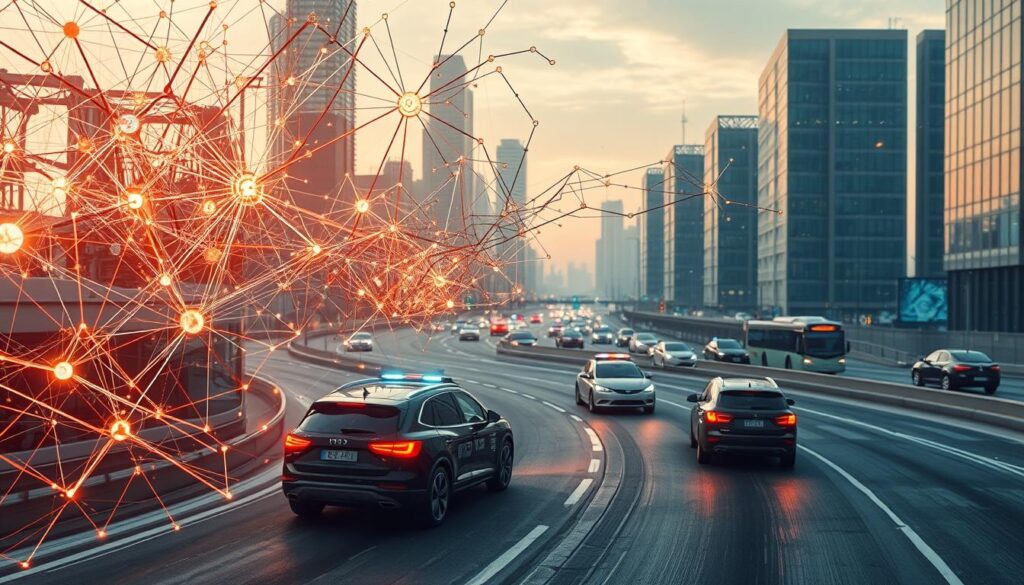Future of Self-Driving Vehicles Today | What’s Next
By 2025, the global self-driving car market is expected to hit $60 billion. This huge growth shows how fast autonomous driving tech is moving. It’s changing how we travel and live.

Exploring self-driving cars, we find a world full of new ideas. From top-notch sensors to AI choices, and from networks to rules, it’s all exciting. This article will show you the latest news, leaders, and how self-driving cars will change our lives.
Key Takeaways
- The global self-driving car market is projected to reach $60 billion by 2025, signaling a transformative shift in transportation.
- Autonomous driving technology is rapidly evolving, with advancements in sensors, AI, and communication networks.
- Self-driving vehicles promise to enhance safety, efficiency, and accessibility, revolutionizing the way we commute.
- Regulatory frameworks and cybersecurity considerations are crucial for the widespread adoption of autonomous driving.
- Emerging technologies, such as ADAS and V2X communication, are shaping the future of self-driving vehicles.
Understanding Autonomous Driving Technology Evolution
The world of driverless cars has made huge strides in recent years. We’ve seen major milestones in self-driving tech and different levels of vehicle autonomy. This journey is both fascinating and crucial for the future of driving.
Key Milestones in Self-Driving Development
Autonomous vehicles have come a long way. The first self-driving car was made by Carnegie Mellon University in the 1980s. Google started its driverless car project in 2010. Now, cars have advanced driver assistance systems (ADAS) that help with driving.
Levels of Vehicle Autonomy Explained
- Level 0: No Automation – The driver has complete control over the vehicle.
- Level 1: Driver Assistance – The vehicle can assist with specific driving tasks, such as steering or acceleration/deceleration.
- Level 2: Partial Automation – The vehicle can perform both steering and acceleration/deceleration under the driver’s supervision.
- Level 3: Conditional Automation – The vehicle can perform all aspects of driving, but the driver must be ready to take control when needed.
- Level 4: High Automation – The vehicle can perform all driving tasks without human intervention in specific environments or conditions.
- Level 5: Full Automation – The vehicle can perform all driving tasks without human intervention in any environment or condition.
Current Technological Capabilities
Today, driverless car tech is advancing fast. Cars use advanced sensors, powerful computers, and smart algorithms. These tools help cars see their surroundings, make decisions, and drive on their own.
Features like lane-keeping and adaptive cruise control are making driving safer. They’re steps towards a future where cars can drive themselves.

| Feature | Description |
|---|---|
| Adaptive Cruise Control | Automatically adjusts the vehicle’s speed to maintain a safe following distance from the car in front. |
| Automatic Emergency Braking | Detects impending collisions and applies the brakes to avoid or mitigate the impact. |
| Lane Keeping Assist | Helps the driver stay centered within the lane by providing gentle steering corrections. |
| Blind Spot Monitoring | Alerts the driver to the presence of vehicles in the vehicle’s blind spots. |
As driverless car tech keeps improving, advanced driver assistance systems (ADAS) will be key. They’ll help make self-driving cars a common sight on the roads.
AI-Powered Vehicle Systems and Machine Learning Integration
The self-driving vehicle industry is growing fast. Artificial intelligence (AI) and machine learning (ML) are key to this growth. They help make self-driving cars better at making decisions and seeing their surroundings.
Machine learning algorithms are at the core of AI in cars. They let self-driving cars learn from different driving situations. These algorithms use lots of data to make smart choices and drive safely.
Thanks to AI and ML, self-driving cars are getting better in many ways. For example:
- AI vision systems can spot and understand objects, people, and dangers on the road.
- ML helps cars predict what others might do, so they can act safely and early.
- AI systems keep learning and adjusting to new situations, making driving smoother and more personal.
As AI and ML keep improving, self-driving cars will change how we travel. They promise a safer, more efficient, and greener way to get around.

Future of Self-Driving Vehicles Today
The future of self-driving cars is changing fast. Top companies and new tech are leading the way. It’s important to know who’s leading, the latest breakthroughs, and when we’ll see these cars on the road.
Current Market Leaders and Innovations
Tesla, Waymo, and Cruise are leading in self-driving tech. Tesla’s Autopilot has set the stage for more advanced features. Waymo is testing its tech hard, aiming for full autonomy. Cruise, backed by General Motors, is also making big strides.
Breakthrough Technologies Shaping the Industry
New tech is key to the future of self-driving vehicles today. AI, machine learning, and sensors help cars see and act. Lidar, radar, and cameras are making self-driving cars safer and more reliable.
Implementation Timeline Predictions
Experts say self-driving cars will roll out slowly but surely. We’ll see more automation soon, but full autonomy is still a few years off. First, we’ll see them in ridesharing and fleets, then in more cars.
| Company | Key Innovations | Projected Timeline |
|---|---|---|
| Tesla | Autopilot system, Fully electric vehicles | Incremental improvements in the next 2-3 years |
| Waymo | Extensive testing, Fully autonomous driving technology | Limited commercial deployment within 3-5 years |
| Cruise | Collaboration with GM, Advanced sensor fusion | Targeted deployment in specific markets in 4-6 years |
Advanced Driver Assistance Systems (ADAS)
The car industry is moving fast towards self-driving cars. Advanced driver assistance systems (ADAS) are key in this journey. They use sensors, cameras, and algorithms to make cars safer and better. This is a big step towards cars that can drive on their own.
ADAS includes many features like adaptive cruise control and lane-keeping assistance. It also has automatic emergency braking and pedestrian detection. These systems watch the car’s surroundings and the driver’s actions. They help prevent accidents and make driving smoother.
- Adaptive Cruise Control: Automatically adjusts the vehicle’s speed to maintain a safe following distance from the car in front.
- Lane-Keeping Assistance: Alerts the driver when the vehicle begins to drift out of its lane and can even make minor steering corrections to keep the car centered.
- Automatic Emergency Braking: Detects potential collisions and applies the brakes automatically to avoid or minimize the impact.
- Pedestrian Detection: Identifies pedestrians and other vulnerable road users, triggering an alert or emergency braking to prevent collisions.
As autonomous vehicle technologies get better, ADAS systems will be even more important. They make driving safer and help test the tech needed for self-driving cars. This tech is key for the future of driving.
Vehicle-to-Everything (V2X) Communication Networks
The future of driving is linked to vehicle-to-everything (V2X) communication networks. These systems let vehicles share important info with their surroundings. This includes other cars, pedestrians, and even city systems.
Infrastructure Requirements
V2X communication needs a strong infrastructure. This includes roadside units (RSUs) that send and receive data. Also, fast wireless tech like 5G is key for quick, reliable info exchange.
Smart City Integration
As smart mobility solutions grow, linking V2X with city systems is key. This connects vehicles to traffic lights and parking. It helps make traffic smoother and reduces jams.
Communication Standards and Protocols
- Standards like DSRC and C-V2X are vital for working together. They ensure all systems can talk to each other.
- These rules set how data is shared. This makes sure vehicles and city systems can communicate smoothly.
| Communication Standard | Frequency Band | Data Rate | Latency |
|---|---|---|---|
| DSRC | 5.9 GHz | 3-27 Mbps | 20-100 ms |
| C-V2X | Cellular (LTE/5G) | 10-500 Mbps | 10-100 ms |
Vehicle-to-everything (V2X) communication networks are key for safe, smart driving. With the right tech and city links, we’re moving towards a future. One where cars and roads work together for better safety and less traffic.
Cybersecurity Challenges in Autonomous Vehicles
The growth of cyber security for self-driving cars and autonomous driving technology raises big security concerns. Self-driving cars have many sensors, systems, and wireless tech. They face unique risks that need to be fixed to keep everyone safe.
One big worry is cyber attacks that could mess with the car’s key functions like steering and brakes. Hackers could get into the car’s systems and control these important parts. This could be very dangerous for the car and its passengers.
- Potential cyber threats include:
- Hacking of the vehicle’s electronic control units (ECUs)
- Exploitation of vulnerabilities in the vehicle’s wireless communication systems
- Injection of malware or ransomware into the vehicle’s software
To fight these dangers, car makers and tech firms are working hard on cybersecurity measures for self-driving cars. They’re doing things like:
- Using strong encryption and checks to keep car-to-car and car-to-road communication safe
- Adding systems to find and stop cyber threats
- Creating ways to update car software safely over the air
- Working with cybersecurity experts to keep up with new threats
As autonomous driving technology gets better, the security problems will get harder. Solving these issues is key to making self-driving cars safe and popular. It’s important for the safety of everyone and the whole transportation system.
| Potential Cyber Threat | Impact on Autonomous Vehicles | Mitigation Strategies |
|---|---|---|
| Hacking of ECUs | Unauthorized control of critical vehicle functions | Robust encryption, secure firmware updates |
| Exploitation of wireless vulnerabilities | Disruption of vehicle-to-vehicle and vehicle-to-infrastructure communication | Secure communication protocols, intrusion detection systems |
| Malware/ransomware injection | Compromise of vehicle software and data systems | Secure software updates, advanced threat detection |
Regulatory Framework and Legal Considerations
Self-driving vehicles are getting more advanced, making rules and laws around them very complex. Governments all over are trying to make good rules for these cars. They want to make sure these cars are safe and work well with our current traffic rules.
Global Policy Development
World leaders and big organizations are working together to make the same rules for self-driving cars. They’re making plans for how to test these cars, who can drive them, and how to keep personal info safe. They also need to figure out who’s at fault if something goes wrong.
Safety Standards and Compliance
- Creating strict safety rules for how these cars are made and how they work
- Setting up tough tests to make sure these cars meet safety standards
- Working with car companies to find the best ways to follow these rules
Liability and Insurance Implications
Self-driving cars bring up big questions about who’s to blame if there’s an accident. Governments are looking into how to decide who’s at fault. They also need to come up with new insurance plans for these cars.
“The successful deployment of autonomous vehicles will depend on the ability to establish a clear and comprehensive regulatory environment that balances innovation with public safety.”
Conclusion
The future of transportation is closely tied to the growth of autonomous driving technology. We’ve seen big steps forward, from the first ideas to today’s leading vehicles and new tech.
AI and machine learning have made self-driving cars smarter. They can handle tough situations, make quick choices, and keep us safer. Systems like ADAS and V2X networks are making our roads smarter and safer too.
Despite challenges like keeping cars safe from hackers and figuring out rules, the future looks bright. Self-driving cars could change how we travel, making it faster and greener. They could make our roads less crowded and our air cleaner. With autonomous tech, we’re on the verge of a big change in how we see and use the world.
FAQ
What is the current state of autonomous driving technology?
Autonomous driving tech has seen big leaps forward. We now have everything from basic driver aids to fully self-driving cars. The goal is to make driving safer, more efficient, and better for everyone.
How do the different levels of vehicle autonomy work?
There are six levels of vehicle autonomy, from no automation to full automation. Level 0 means no help, while Level 5 means no driver needed. Each level adds more control and assistance for the vehicle.
What are the key technological capabilities of self-driving vehicles?
Self-driving cars use sensors, computer vision, and AI to understand and act on their surroundings. They have advanced radar, lidar, cameras, and machine learning. These tools help them handle different driving situations.
Who are the leading companies in the autonomous driving industry?
Big names in self-driving cars include Tesla, Waymo, Cruise, Uber, and Baidu. Apple and Nvidia are also key players. They’re all working hard to improve their tech.
What are some of the breakthrough technologies shaping the future of self-driving vehicles?
New tech like 5G, V2X communication, and AI is changing self-driving cars. These advancements help with faster data processing, better object detection, and smart city integration.
How are Advanced Driver Assistance Systems (ADAS) contributing to autonomous driving?
ADAS features like automatic braking and lane-keeping help move us towards self-driving cars. They make driving safer and are steps towards more automation.
What is the role of vehicle-to-everything (V2X) communication in autonomous driving?
V2X lets self-driving cars share data with other vehicles and the road. This improves awareness, traffic flow, and decision-making. It’s key for safe, efficient driving in smart cities.
What are the key cybersecurity concerns for autonomous vehicles?
As self-driving cars rely more on digital systems, cybersecurity threats grow. Hacking, data breaches, and system failures could harm safety and privacy. Strong security measures are essential.
How is the regulatory framework for autonomous vehicles evolving?
Governments are creating rules and standards for self-driving cars. They’re tackling issues like liability, insurance, and ethics. This ensures safe and responsible use of the technology.

